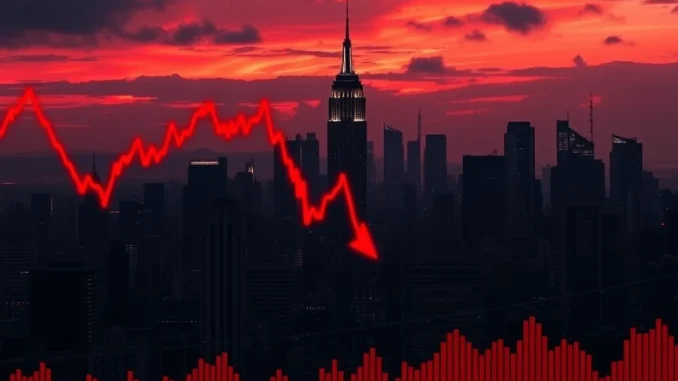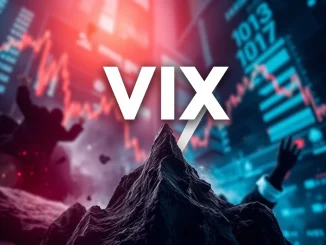
Urgent Alert: The opening bell on Wall Street has rung, and it’s echoing a somber tune for investors worldwide. If you’re tracking your portfolio, especially within the volatile cryptocurrency space, you’ll want to pay close attention to the seismic shifts happening in traditional markets. Today, we’re witnessing a significant stock market downturn as U.S. stock markets opened sharply lower, sending ripples of concern through the financial world. Let’s dive into the details of this alarming market activity and understand what’s driving this downward spiral.
Decoding the Initial Shock: Key Market Indicators Plunge
The numbers are stark and paint a clear picture of a market under pressure. Here’s a snapshot of how the major U.S. stock market indices are performing at the open:
- S&P 500: A significant drop of -2.37%. This broad market index, representing 500 of the largest U.S. companies, is a key barometer of overall market health. A decline of this magnitude signals widespread selling pressure across various sectors.
- NASDAQ Composite: Experiencing the most severe fall at -3.6%. The tech-heavy NASDAQ is often seen as a growth indicator, and such a steep decline suggests investors are particularly wary of growth stocks and the technology sector amid current economic conditions.
- Dow Jones Industrial Average: Down by -1.14%. The Dow, composed of 30 large, blue-chip companies, is generally considered more stable than the NASDAQ. However, even this index is showing considerable weakness, indicating broad market unease.
These figures are not just numbers; they represent billions of dollars in market capitalization evaporating within the first hours of trading. But what are the underlying factors fueling this market volatility? Let’s explore some potential reasons.
Unpacking the Reasons Behind the Downturn: What’s Causing the Market Jitters?
Several macroeconomic factors and investor anxieties are likely contributing to this early market slump. While pinpointing the exact cause is complex, here are some key elements to consider:
- Inflationary Pressures: Persistent inflation remains a primary concern. Despite efforts to curb rising prices, inflation figures have remained stubbornly high, eroding purchasing power and forcing central banks to consider more aggressive measures.
- Interest Rate Hikes: In response to inflation, central banks, particularly the Federal Reserve in the U.S., have been raising interest rates. Higher interest rates increase borrowing costs for businesses and consumers, potentially slowing economic growth and impacting corporate earnings. The anticipation of further rate hikes can trigger market sell-offs.
- Geopolitical Uncertainty: Global events, such as ongoing conflicts and international tensions, contribute to market instability. Geopolitical risks can disrupt supply chains, increase energy prices, and create a climate of uncertainty, prompting investors to reduce risk exposure.
- Earnings Season Concerns: As earnings season progresses, investors are closely scrutinizing corporate reports for signs of weakening profitability. If companies are projecting lower earnings or expressing caution about future outlooks, it can negatively impact stock valuations.
- Profit Taking and Market Correction: After periods of market gains, some investors may engage in profit-taking, selling off assets to secure returns. This can contribute to a broader market correction, especially if triggered by negative news or economic data.
Understanding these factors helps to contextualize the current market movements. However, for cryptocurrency enthusiasts, the crucial question is: how does this traditional market turmoil affect the digital asset space?
The Crypto Contagion? How Traditional Market Downturns Impact Cryptocurrency
The cryptocurrency market, while often touted as an uncorrelated asset class, has increasingly shown sensitivity to traditional market trends. When traditional markets experience significant market volatility, it can have several repercussions for the crypto sphere:
- Risk-Off Sentiment: When investors become risk-averse in traditional markets, this sentiment often spills over into the cryptocurrency market. Cryptocurrencies are generally perceived as higher-risk assets compared to stocks or bonds. In times of uncertainty, investors tend to reduce exposure to riskier assets across the board.
- Liquidity Concerns: Market downturns can trigger liquidity crunches. Investors may sell off more liquid assets, including cryptocurrencies, to cover losses or meet margin calls in other parts of their portfolios. This can exacerbate downward price pressure in the crypto market.
- Correlation Increase: While long-term correlation may be debatable, in the short term, especially during periods of market stress, the correlation between traditional markets (particularly tech stocks) and cryptocurrencies like Bitcoin and Ethereum often tends to increase. This means that when stocks fall, cryptos are more likely to follow suit.
- Institutional Investor Behavior: The growing institutional participation in the cryptocurrency market means that institutional trading strategies and risk management practices can link crypto performance more closely to traditional market dynamics.
Therefore, the current stock market downturn should be viewed as a significant development for cryptocurrency investors. It signals a broader risk-off environment that could exert downward pressure on crypto prices as well.
Decoding Investor Sentiment: Fear and Uncertainty Grips the Market
Beyond the technical and economic factors, investor sentiment plays a crucial role in market movements. Market psychology, driven by emotions like fear and greed, can amplify market trends. In the current scenario, several indicators point towards a shift towards fear and caution:
- Fear Gauge Spikes: The CBOE Volatility Index (VIX), often referred to as the “fear gauge,” typically rises during periods of market stress. A significant increase in the VIX indicates heightened investor anxiety and expectations of further market volatility.
- Safe-Haven Assets: In times of uncertainty, investors often flock to perceived safe-haven assets like gold or government bonds. Increased demand for these assets can be another sign of risk aversion and a flight from equities and riskier assets.
- Social Media Sentiment: Monitoring social media and financial news sentiment can provide insights into prevailing market psychology. A surge in negative news headlines and pessimistic commentary can further dampen investor confidence.
- Selling Volume: High selling volume, particularly at the market open, suggests strong bearish sentiment and a rush to exit positions.
Understanding investor sentiment is crucial for navigating volatile market conditions. Fear can be contagious, and it can drive market downturns beyond what fundamental factors might justify. However, it’s also important to remember that market sentiment can shift rapidly.
Navigating Economic Uncertainty: Strategies for Investors
The current economic uncertainty and market volatility present challenges but also opportunities for investors. Here are some actionable insights and strategies to consider:
- Review Portfolio Risk: Assess your portfolio’s risk exposure. Ensure your asset allocation aligns with your risk tolerance and investment goals, especially in light of increased market volatility.
- Diversification: Diversification remains a cornerstone of risk management. Spreading investments across different asset classes, sectors, and geographies can help mitigate the impact of downturns in any single area.
- Dollar-Cost Averaging: Consider dollar-cost averaging, especially for long-term investments. Investing a fixed amount of money at regular intervals, regardless of market fluctuations, can help smooth out entry points and reduce the risk of investing a lump sum at market peaks.
- Stay Informed and Do Your Research: Keep abreast of market developments, economic news, and company earnings. Informed decision-making is crucial in volatile times.
- Long-Term Perspective: Remember that market corrections and downturns are a normal part of the economic cycle. Maintaining a long-term investment perspective can help you weather short-term volatility and avoid making emotionally driven decisions.
Conclusion: Weathering the Storm and Looking Ahead
The U.S. stock markets have opened lower, and the initial reaction is one of concern and heightened market volatility. Factors ranging from persistent inflation and interest rate hikes to geopolitical uncertainty and shifting investor sentiment are contributing to this downward pressure. For cryptocurrency investors, it’s crucial to recognize the potential spillover effects and manage risk accordingly.
While market downturns can be unsettling, they also present opportunities for strategic investors. By staying informed, maintaining a long-term perspective, and focusing on sound investment principles, it’s possible to navigate these turbulent times and position yourself for future market recoveries. The key is to remain vigilant, adaptable, and disciplined in your investment approach as we navigate this period of economic uncertainty.



